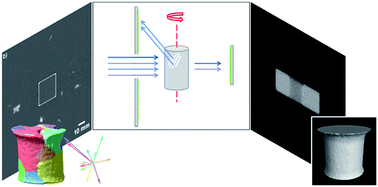Cold neutron diffraction contrast tomography of polycrystalline material†
Abstract
Traditional neutron imaging is based on the attenuation of a neutron beam through scattering and absorption upon traversing a sample of interest. It offers insight into the sample's material distribution at high spatial resolution in a non-destructive way. In this work, it is expanded to include the diffracted neutrons that were ignored so far and obtain a crystallographic distribution (grain mapping). Samples are rotated in a cold neutron beam of limited wavelength band. Projections of the crystallites formed by the neutrons they diffract are captured on a two dimensional imaging detector. Their positions on the detector reveal their orientation whereas the projections themselves are used to reconstruct the shape of the grains. Indebted to established synchrotron diffraction contrast tomography, this ‘cold neutron diffraction contrast tomography’ is performed on recrystallized aluminium for experimental comparison between both. Differences between set-up and method are discussed, followed by the application range in terms of sample properties (crystallite size and number, mosaicity and typical materials). Neutron diffraction contrast tomography allows to study large grains in bulky metallic structures.


 Please wait while we load your content...
Please wait while we load your content...